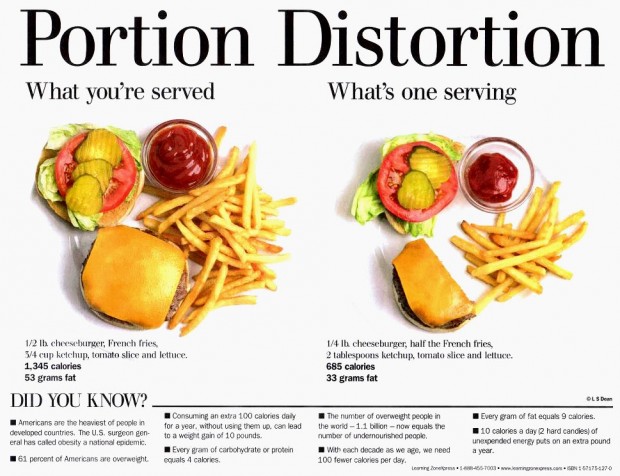Obesity in the USA: Regain Control on Food You Eat
I used to be one of those people who did not like to go to the higher end, gourmet or “healthy” restaurants.
It wasn’t because I didn’t like the food, or that the atmosphere was not to my liking, it was because they served, in what had become my Americanized idea of meal size, “skimpy portions”.
However, the older I got, and the more educated I became on nutrition and healthy eating, I realized that these gourmet restaurants had it all right. Instead of focusing on quantity, they focused more on quality, and limited the portions on the plate to what was actually a healthy, moderate calorie count.
The American ideal of “the bigger the better” spilled over into our food consumption and portion rationing at meals not too long ago actually. After the great depression era, when Americans started to regain control over their finances, and foods and luxury items became more affordable, our portion sizes began to expand.
Obesity still existed before this point, but since then it has spun out of control.
Obesity has also taken a turn for the worse because not only are the portion sizes getting bigger, but the foods we eat are higher in fat, sodium and sugars, a result of excessive processing and chemical additives, which build up in our system and cause obesity, diabetes, heart disease, mood disorders and countless other health issues which stem from excess weight.
In fact, chefs from some of the most popular American restaurants were recently surveyed, and reported that calorie count was the least of their concerns when they created signature dishes for the restaurants they worked for.
About one in six said that they even considered the calorie count aspect.
They based their creations on flavor instead, casting aside portion size and fat content, etc., all of which add to the calorie count of a meal.
What can you do to avoid overeating if you frequent restaurants?
- Make sure you fill up on the salad, and get a low fat dressing, which can cut up to 100 calories from your meal many times.
- Unless you are going to a health food restaurant, or one that you know serves smaller, more controlled portions, you probably should not be finishing your meal.
- Take your time eating. Do not inhale your food.
Did you know that it takes your mind about 20 minutes to reigster that you are full?
This is why many times you will feel just “satisfied” and pleasantly fulfilled when you finish a meal, and then about twenty minutes to a half hour later you feel ridiculously stuffed.
Ask for a box to take the rest home.
This way, you will also not regret eating that big meal, and also will not be dealing with the effects of overeating, like sleepiness, mental fogginess, indigestion, gas pains, and cramping. It’s a win/win situation.
The increasing obesity epidemic has gotten so out of control that we now have gastric bypass surgery, which thousand of obese Americans elect to have each year, even though the surgery is extremely serious and many times life threatening.
This is in direct response to a culture that grew up being under educated about portion control and wise food choices.
Many individuals in the baby boom era were not educated to the extent we are today about nutrition, how certain fats protect organs and well being, and others aid in their destruction, the effects of sugars on the body, and the effects of excess calorie consumption.
Most health professionals are hoping that the improved health and nutrition education available to the general public today will eventually whittle away at the obesity epidemic by making generation after generation more educated and armed with the knowledge they need to lead a healthy lifestyle.
What will happen in the future regarding health awareness and education?
It’s been in the news lately that the government is actually stepping in as a proactive measure against further obesity and health issues. Government officials recently tried to ban trans fats from being used in restaurant cooking.
The NFL also has stepped in to band against childhood obesity by educating youths in schools about exercise and proper diet, and are also campaigning for reform in the public school’s physical education classes, since it was found that “gym class” typically involves less than 20 minutes of actual physical activity.
Can we eliminate obesity all together?
With all of these changes going on, and a growing awareness in the American public about nutrition, portion control, calorie consumption and healthy food choices, one can only be optimistic about the future health of America.






